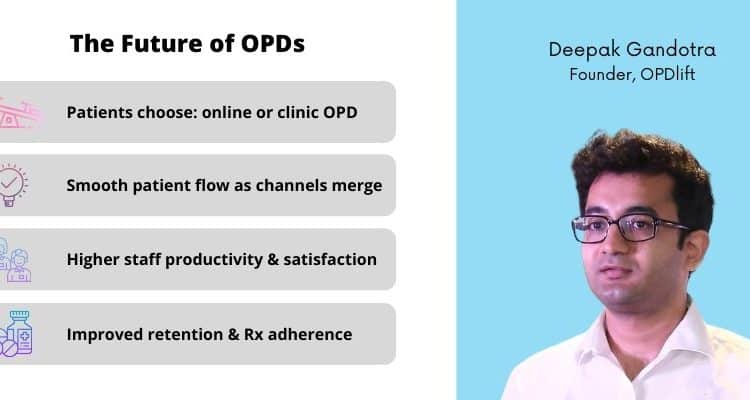While many industries spent the last decade innovating their delivery experience, finally it is time for healthcare. And while telemedicine is the talk of the town, what will be the new normal once the unlocking is over? Deepak Gandotra, Founder, OPDlift in this article introduces us to the concept of Hybrid OPD in the post COVID Era
Healthcare prides itself on being one-of-its-kind. After all, no other industry or sector comes close to dealing with as many emotions, stakeholders and regulations and delivering the social impact that healthcare does. While dealing with life and death sets it apart, it also brings a wiggle room towards changing the status quo.
I entered healthcare almost a decade back and the doctrine of its transformation was never kept secret. Personal health records (PHR) were touted to be the next-big-thing but we all witnessed the rise and fall of Microsoft Healthvault that officially shut down last year. Similarly, telemedicine projects by marquee hospitals and tech giants in India and abroad failed to gain momentum. And, Healthcare watched with bated breath while E-commerce and Fintech zoomed past in innovation and customer experience in the past five years. But the need is the mother of invention, they say, and while COVID-19 brought the whole world to a standstill, healthcare became the torchbearer for humanity.
The overkill of telemedicine
Every villain needs a hero and COVID-19 found one in Telemedicine. Managing millions of Coronavirus suspects required triaging, followed by consultations and treatment support. It was unimaginable in the offline world. But in a country where e-commerce and ride-hailing boomed only after companies embraced Cash on Delivery/Pay on Ride, the love for touch-and-feel experience is by no means lost.
So, is telemedicine the new normal or will people jump ship to the classic clinic consultation format? Going by the market size of OPD consultations, this question is worth much more than a million-dollar. While dealing with extremes is more glorified, the reality in most cases lie somewhere in between. So, the real question that we should be asking ourselves is – what would be the distribution between online and offline consultations.
Here comes Hybrid OPD
The delivery model of healthcare has permanently changed. Let’s call it Hybrid OPD. So, what does a Hybrid OPD look like?
- Patients get an option to choose between online and offline consultations without compromising on their healthcare experience or outcomes.
- Doctors have fewer disruptions in their patient flow as the three formats of incoming patients (walk-ins, appointments, telemedicine) merge
- Improvement in productivity and job satisfaction of clinic and hospital staff as mundane tasks such as queue management and appointment bookings are automated
- Higher patient retention and improved medical adherence due to easier consultation processes will lead to a virtuous cycle of a loyal patient base that gradually increases
- And most important, improvement in disease awareness and preventative healthcare because of digital patient engagement for both online and offline consultation formats
One might argue that enabling Hybrid OPD and seeing improvement in treatment compliance is an exaggeration. Our data from pre-COVID times shows that nudging the patients with just two WhatsApp messages improved compliance by as much as 40 per cent and significantly reduces appointment no-shows. Hybrid OPDs will do just that and some more.
But as we get fascinated by the glamour of online, we must not lose track of the ground reality. Is it a coincidence that the city of Mumbai which is facing the worst COVID-19 crisis in our country also holds the grim record of 25 per cent anti-microbial resistance (AMR) among its patients to the high potency antibiotic called fluoroquinolone (as per Mumbai’s Antimicrobial Resistance Report, 2019, November 2019). Fluoroquinolone and hydroxychloroquine belong to the same family of quinolone drugs. I shall not assert any correlation or causation between COVID-19 and AMR as it is an extremely sensitive subject and any connection must be drawn by medical researchers after a detailed study. Having said that, AMR is a global issue and India is one of the worst affected regions due to the overuse and lack of oversight on antibiotics. AMR causes seven lac deaths every year. These are more fatalities than cancer and road traffic accidents, combined.
We are no more at the cusp of the healthcare revolution. We are part of it. Innovations such as contactless clinics where patients will not be contacted or touched by anyone except a doctor (only if required) could become a norm in a few years. We have already started observing the benefits of Hybrid OPDs. And the importance of delivering integrated healthcare cannot be overstated. Why would a patient want to step out after an online consultation? Home delivery of medicines and diagnostics would become the norm not luxury. In case you missed, we did not even discuss the possibilities of virtual referrals, OPD coverage by insurance companies and the crucial role that pharma would play in the post COVID era!
Just a reminder, we are still reading the first page of this gripping book, called the future of healthcare.
- Advertisement -


